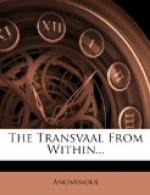of the besieging operations and compelled them to work
in the trenches in exposed positions so that they
should be—and actually were—shot
by their own comrades. There was also the incident
in which he refused to allow one or two of the ladies
who were among the beleaguered garrison, and who were
then in extremely bad health, to leave the fort to
obtain such food and medical attendance as would enable
them to live. One of the ladies died in consequence.
But the incident which has more bearing on Jameson’s
surrender than any other is that connected with the
armistice, when Commandant Cronje, in defiance of
treaty obligations, withheld from Colonel Winslow
and the besieged garrison the news that an armistice
had been arranged between the Boer and British forces,
and continued the siege until the garrison, in order
to save the lives of the wounded and the women and
children refugees, were obliged to surrender.
It will be remembered that this incident was too much
even for Mr. Gladstone, and that on its becoming known
after the terms of peace had been settled, the Transvaal
Government were required by Sir Evelyn Wood to allow
a British force to march up from Natal and re-occupy
Potchefstroom as a formal acknowledgment of Cronje’s
treachery. Mr. Kruger and his party, who were
in the greatest fear that the settlement would not
be effected, and that Sir Evelyn Wood’s action
might provoke a renewal of hostilities, agreed to the
terms, but with grave apprehensions as to the results.
However, no
contretemps occurred.
{32} Once when out hunting on foot—a young
man then—Mr. Kruger, after climbing to
the top of a kopje, found that he had been seen by
a number of hostile natives who were then running towards
him, some to climb the hill, others branching out
to surround it. He knew that those on the flat
could cut him off before he could descend and that
his only chance lay in ‘bluff.’ Stepping
on to the outermost ledge in full view of the enemy
he calmly laid down his rifle, drew off first one
and then the other of his velschoens (home-made hide
shoes, in those poorer days worn without socks) and
after quietly knocking the sand out of them drew them
on again. By this time the natives had stopped
to observe him. He then picked up his rifle again,
and turning to an imaginary force behind the kopje
waved to the right and then to the left, as though
directing them to charge round each end of the hill.
The next instant the Kaffirs were in full retreat.
CHAPTER VII.
AFTER DOORNKOP.
The news of Dr. Jameson’s surrender was received
in Johannesburg towards mid-day, at first with derision,
but as report after report came in, each confirming
and supplementing the other, no room for doubt was
left and a scene of the wildest excitement ensued.
It is not too much to say that not one person in a
hundred, no matter what his political leanings were,
had doubted for a moment Dr. Jameson’s ability




